2003 FORD F SERIES MOTORHOME AND COMMERCIAL CHASSIS adding oil
[x] Cancel search: adding oilPage 9 of 96
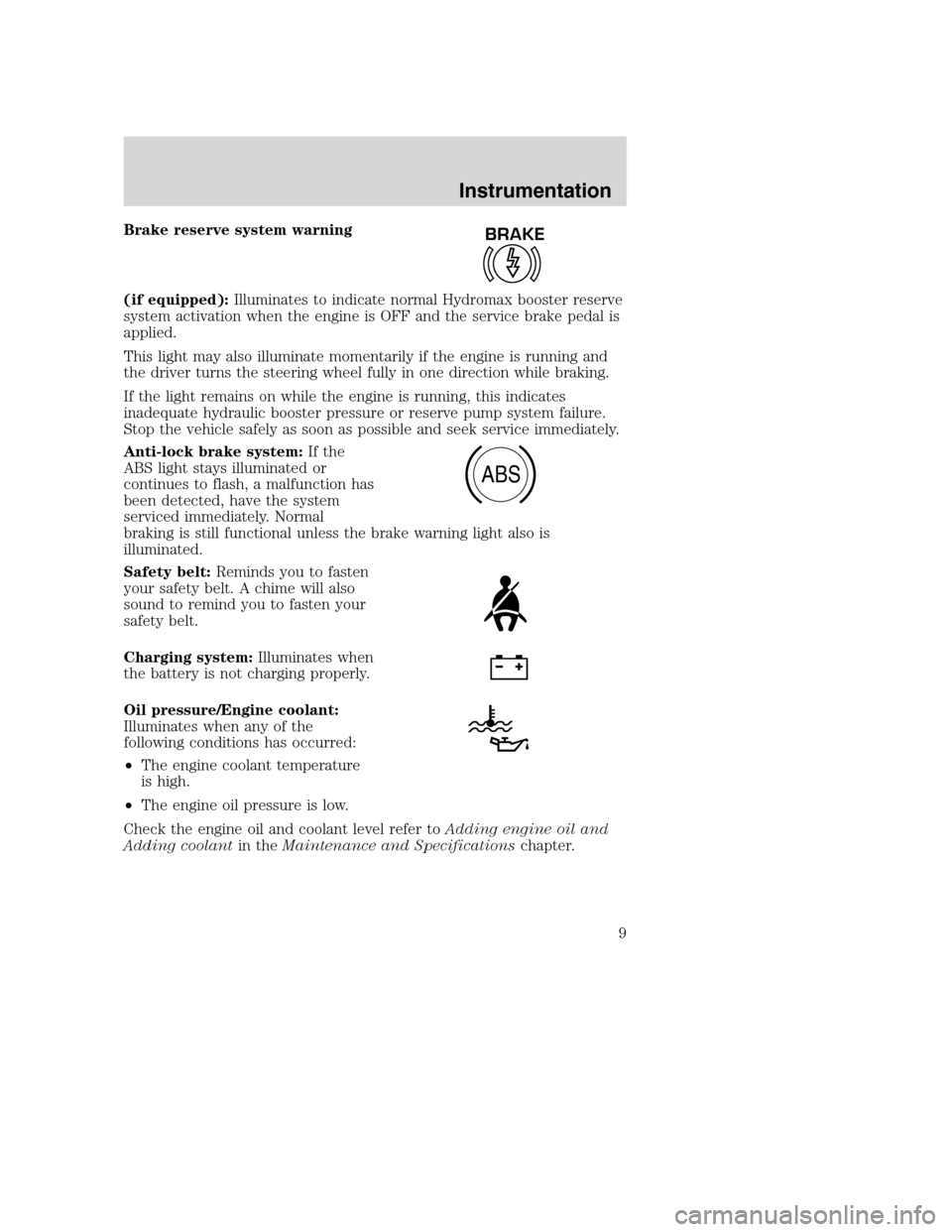
Brake reserve system warning
(if equipped):Illuminates to indicate normal Hydromax booster reserve
system activation when the engine is OFF and the service brake pedal is
applied.
This light may also illuminate momentarily if the engine is running and
the driver turns the steering wheel fully in one direction while braking.
If the light remains on while the engine is running, this indicates
inadequate hydraulic booster pressure or reserve pump system failure.
Stop the vehicle safely as soon as possible and seek service immediately.
Anti-lock brake system:If the
ABS light stays illuminated or
continues to flash, a malfunction has
been detected, have the system
serviced immediately. Normal
braking is still functional unless the brake warning light also is
illuminated.
Safety belt:Reminds you to fasten
your safety belt. A chime will also
sound to remind you to fasten your
safety belt.
Charging system:Illuminates when
the battery is not charging properly.
Oil pressure/Engine coolant:
Illuminates when any of the
following conditions has occurred:
•The engine coolant temperature
is high.
•The engine oil pressure is low.
Check the engine oil and coolant level refer toAdding engine oil and
Adding coolantin theMaintenance and Specificationschapter.BRAKE
ABS
Instrumentation
9
Page 57 of 96
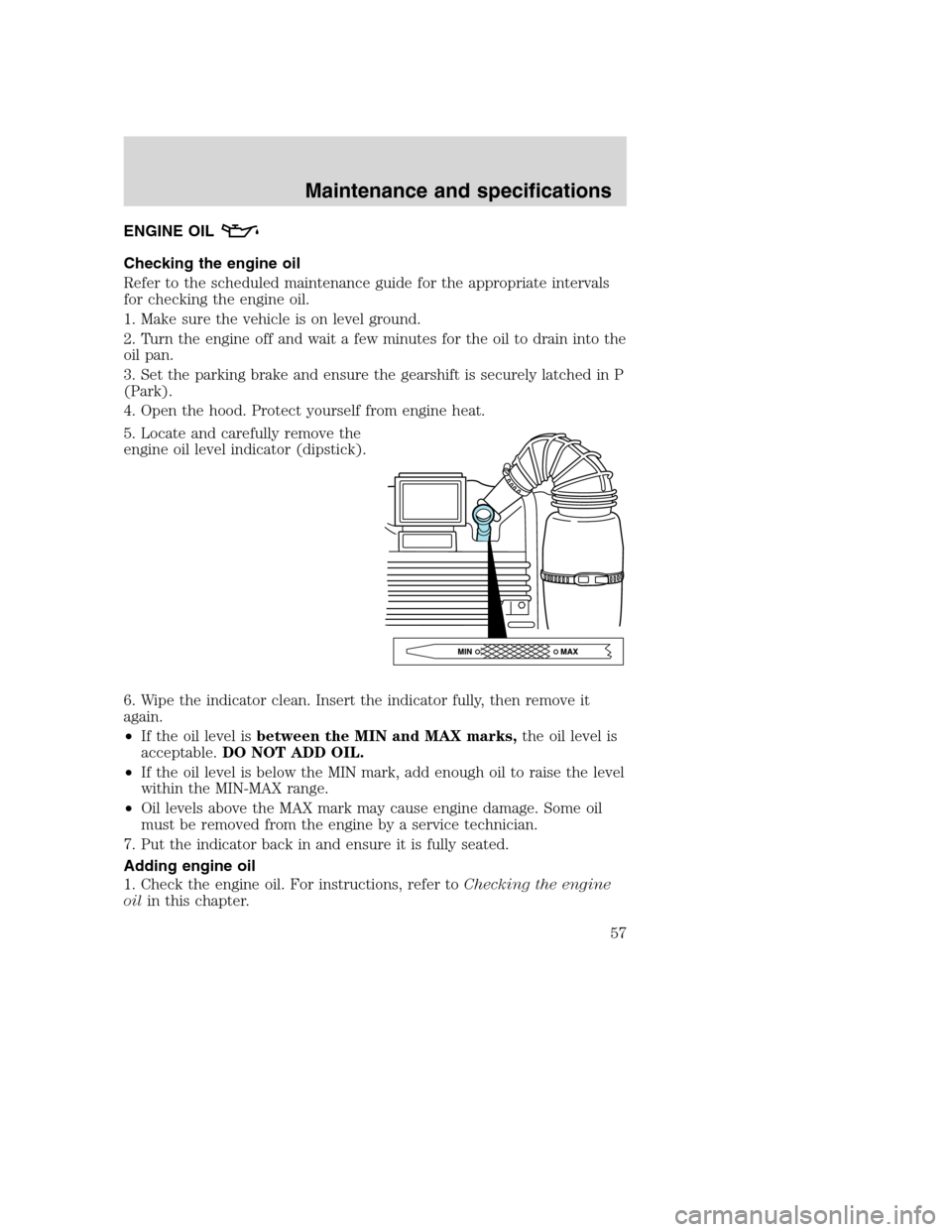
ENGINE OIL
Checking the engine oil
Refer to the scheduled maintenance guide for the appropriate intervals
for checking the engine oil.
1. Make sure the vehicle is on level ground.
2. Turn the engine off and wait a few minutes for the oil to drain into the
oil pan.
3. Set the parking brake and ensure the gearshift is securely latched in P
(Park).
4. Open the hood. Protect yourself from engine heat.
5. Locate and carefully remove the
engine oil level indicator (dipstick).
6. Wipe the indicator clean. Insert the indicator fully, then remove it
again.
•If the oil level isbetween the MIN and MAX marks,the oil level is
acceptable.DO NOT ADD OIL.
•If the oil level is below the MIN mark, add enough oil to raise the level
within the MIN-MAX range.
•Oil levels above the MAX mark may cause engine damage. Some oil
must be removed from the engine by a service technician.
7. Put the indicator back in and ensure it is fully seated.
Adding engine oil
1. Check the engine oil. For instructions, refer toChecking the engine
oilin this chapter.
Maintenance and specifications
57
Page 61 of 96
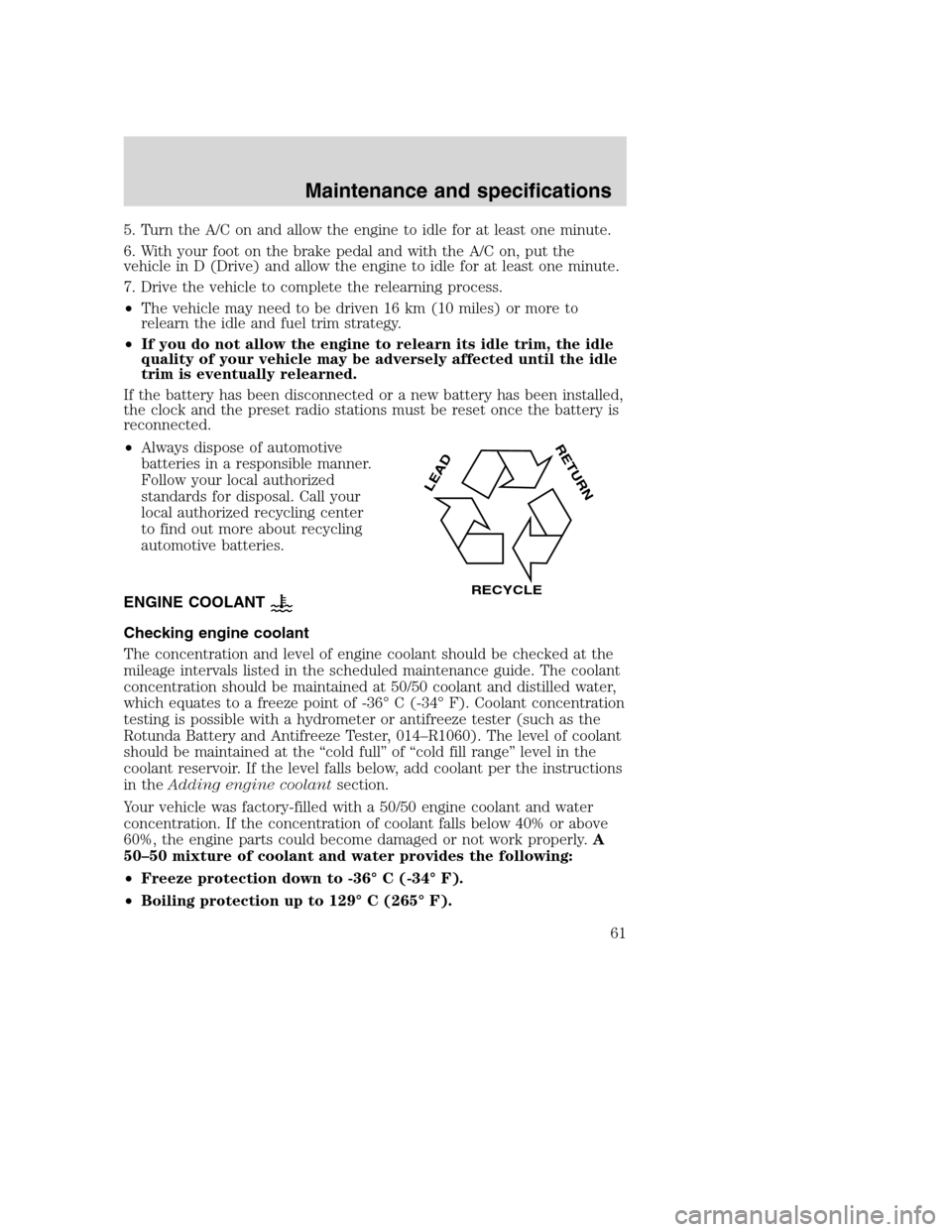
5. Turn the A/C on and allow the engine to idle for at least one minute.
6. With your foot on the brake pedal and with the A/C on, put the
vehicle in D (Drive) and allow the engine to idle for at least one minute.
7. Drive the vehicle to complete the relearning process.
•The vehicle may need to be driven 16 km (10 miles) or more to
relearn the idle and fuel trim strategy.
•If you do not allow the engine to relearn its idle trim, the idle
quality of your vehicle may be adversely affected until the idle
trim is eventually relearned.
If the battery has been disconnected or a new battery has been installed,
the clock and the preset radio stations must be reset once the battery is
reconnected.
•Always dispose of automotive
batteries in a responsible manner.
Follow your local authorized
standards for disposal. Call your
local authorized recycling center
to find out more about recycling
automotive batteries.
ENGINE COOLANT
Checking engine coolant
The concentration and level of engine coolant should be checked at the
mileage intervals listed in the scheduled maintenance guide. The coolant
concentration should be maintained at 50/50 coolant and distilled water,
which equates to a freeze point of -36° C (-34° F). Coolant concentration
testing is possible with a hydrometer or antifreeze tester (such as the
Rotunda Battery and Antifreeze Tester, 014–R1060). The level of coolant
should be maintained at the “cold full” of “cold fill range” level in the
coolant reservoir. If the level falls below, add coolant per the instructions
in theAdding engine coolantsection.
Your vehicle was factory-filled with a 50/50 engine coolant and water
concentration. If the concentration of coolant falls below 40% or above
60%, the engine parts could become damaged or not work properly.A
50–50 mixture of coolant and water provides the following:
•Freeze protection down to -36° C (-34° F).
•Boiling protection up to 129° C (265° F).
LEAD
RETURN
RECYCLE
Maintenance and specifications
61
Page 94 of 96
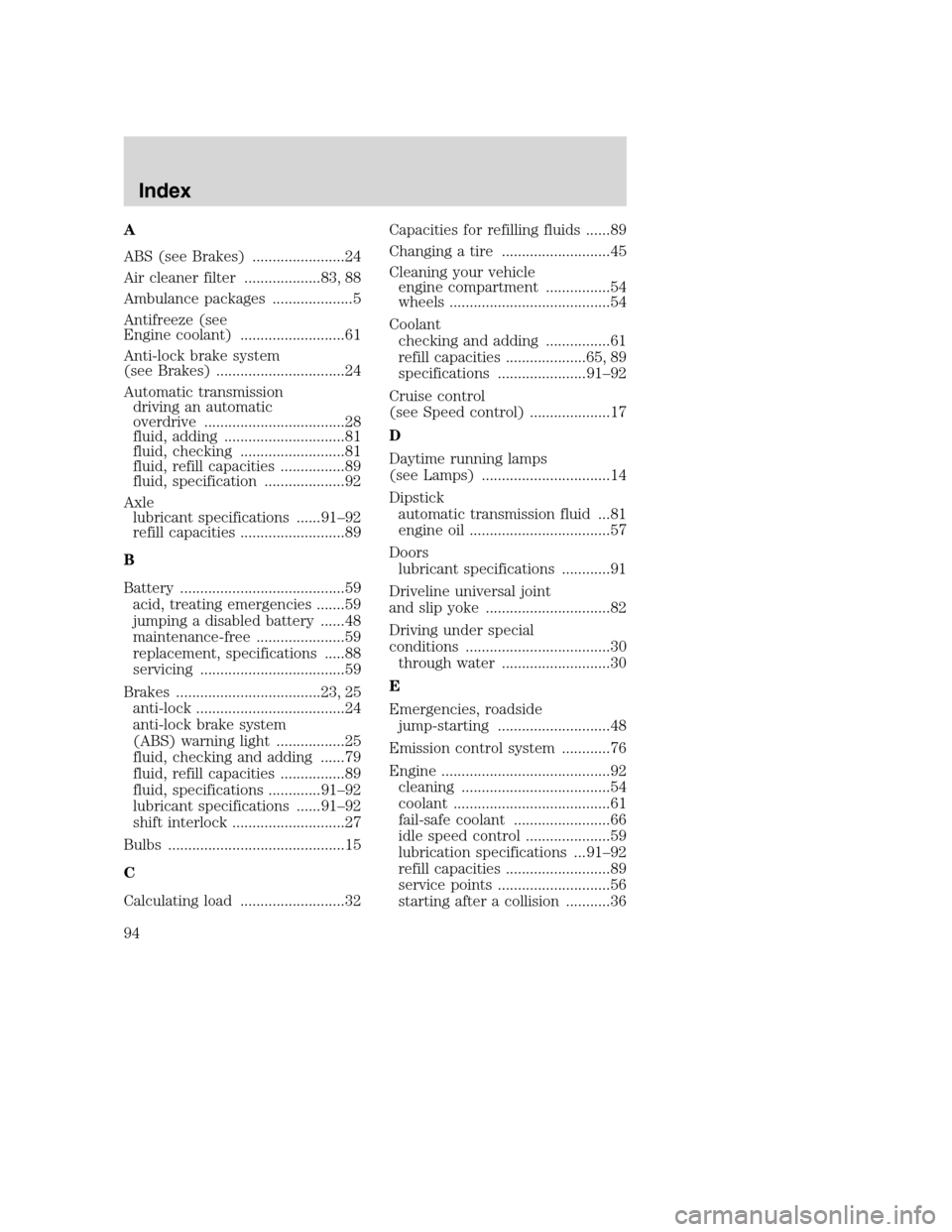
A
ABS (see Brakes) .......................24
Air cleaner filter ...................83, 88
Ambulance packages ....................5
Antifreeze (see
Engine coolant) ..........................61
Anti-lock brake system
(see Brakes) ................................24
Automatic transmission
driving an automatic
overdrive ...................................28
fluid, adding ..............................81
fluid, checking ..........................81
fluid, refill capacities ................89
fluid, specification ....................92
Axle
lubricant specifications ......91–92
refill capacities ..........................89
B
Battery .........................................59
acid, treating emergencies .......59
jumping a disabled battery ......48
maintenance-free ......................59
replacement, specifications .....88
servicing ....................................59
Brakes ....................................23, 25
anti-lock .....................................24
anti-lock brake system
(ABS) warning light .................25
fluid, checking and adding ......79
fluid, refill capacities ................89
fluid, specifications .............91–92
lubricant specifications ......91–92
shift interlock ............................27
Bulbs ............................................15
C
Calculating load ..........................32Capacities for refilling fluids ......89
Changing a tire ...........................45
Cleaning your vehicle
engine compartment ................54
wheels ........................................54
Coolant
checking and adding ................61
refill capacities ....................65, 89
specifications ......................91–92
Cruise control
(see Speed control) ....................17
D
Daytime running lamps
(see Lamps) ................................14
Dipstick
automatic transmission fluid ...81
engine oil ...................................57
Doors
lubricant specifications ............91
Driveline universal joint
and slip yoke ...............................82
Driving under special
conditions ....................................30
through water ...........................30
E
Emergencies, roadside
jump-starting ............................48
Emission control system ............76
Engine ..........................................92
cleaning .....................................54
coolant .......................................61
fail-safe coolant ........................66
idle speed control .....................59
lubrication specifications ...91–92
refill capacities ..........................89
service points ............................56
starting after a collision ...........36
Index
94
Page 95 of 96
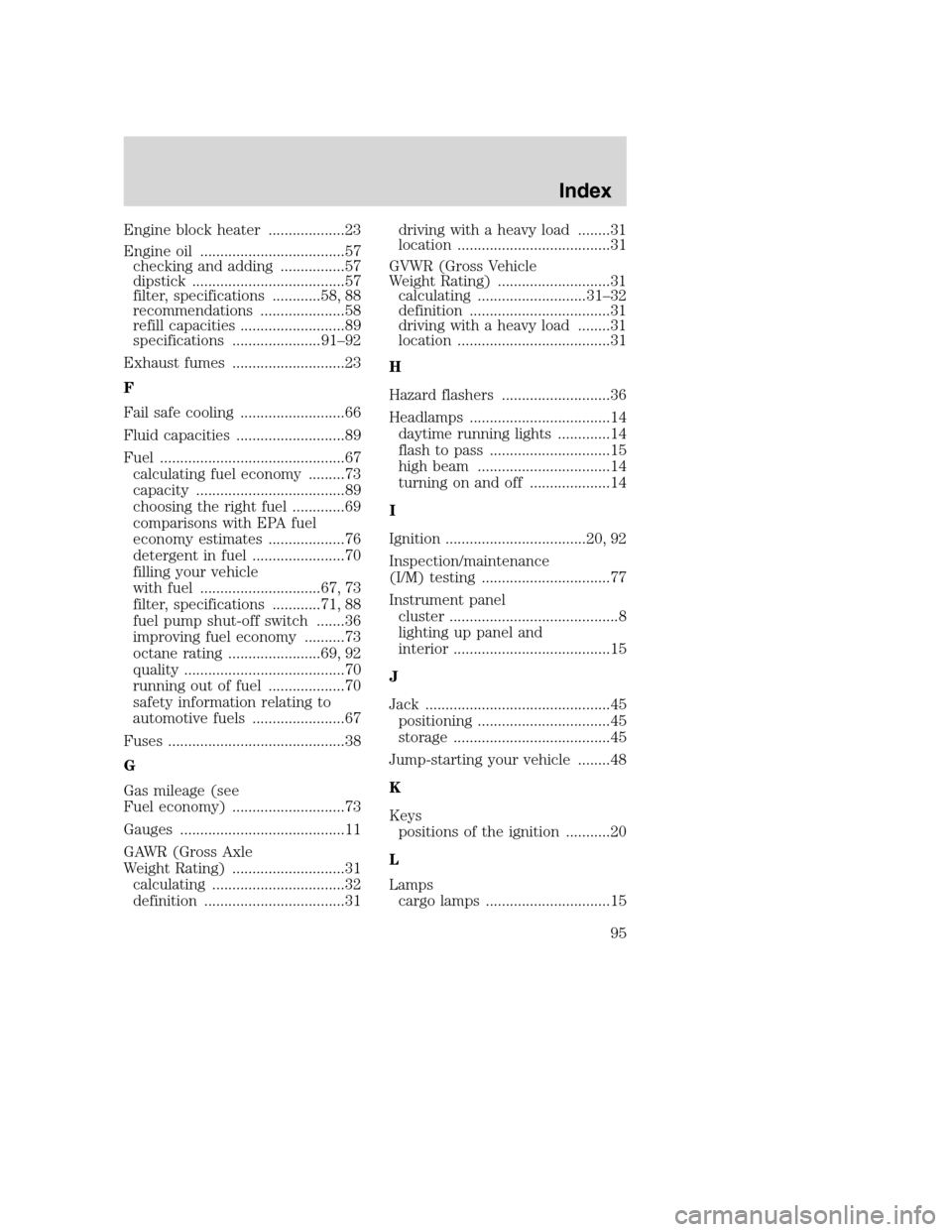
Engine block heater ...................23
Engine oil ....................................57
checking and adding ................57
dipstick ......................................57
filter, specifications ............58, 88
recommendations .....................58
refill capacities ..........................89
specifications ......................91–92
Exhaust fumes ............................23
F
Fail safe cooling ..........................66
Fluid capacities ...........................89
Fuel ..............................................67
calculating fuel economy .........73
capacity .....................................89
choosing the right fuel .............69
comparisons with EPA fuel
economy estimates ...................76
detergent in fuel .......................70
filling your vehicle
with fuel ..............................67, 73
filter, specifications ............71, 88
fuel pump shut-off switch .......36
improving fuel economy ..........73
octane rating .......................69, 92
quality ........................................70
running out of fuel ...................70
safety information relating to
automotive fuels .......................67
Fuses ............................................38
G
Gas mileage (see
Fuel economy) ............................73
Gauges .........................................11
GAWR (Gross Axle
Weight Rating) ............................31
calculating .................................32
definition ...................................31driving with a heavy load ........31
location ......................................31
GVWR (Gross Vehicle
Weight Rating) ............................31
calculating ...........................31–32
definition ...................................31
driving with a heavy load ........31
location ......................................31
H
Hazard flashers ...........................36
Headlamps ...................................14
daytime running lights .............14
flash to pass ..............................15
high beam .................................14
turning on and off ....................14
I
Ignition ...................................20, 92
Inspection/maintenance
(I/M) testing ................................77
Instrument panel
cluster ..........................................8
lighting up panel and
interior .......................................15
J
Jack ..............................................45
positioning .................................45
storage .......................................45
Jump-starting your vehicle ........48
K
Keys
positions of the ignition ...........20
L
Lamps
cargo lamps ...............................15
Index
95
Page 96 of 96
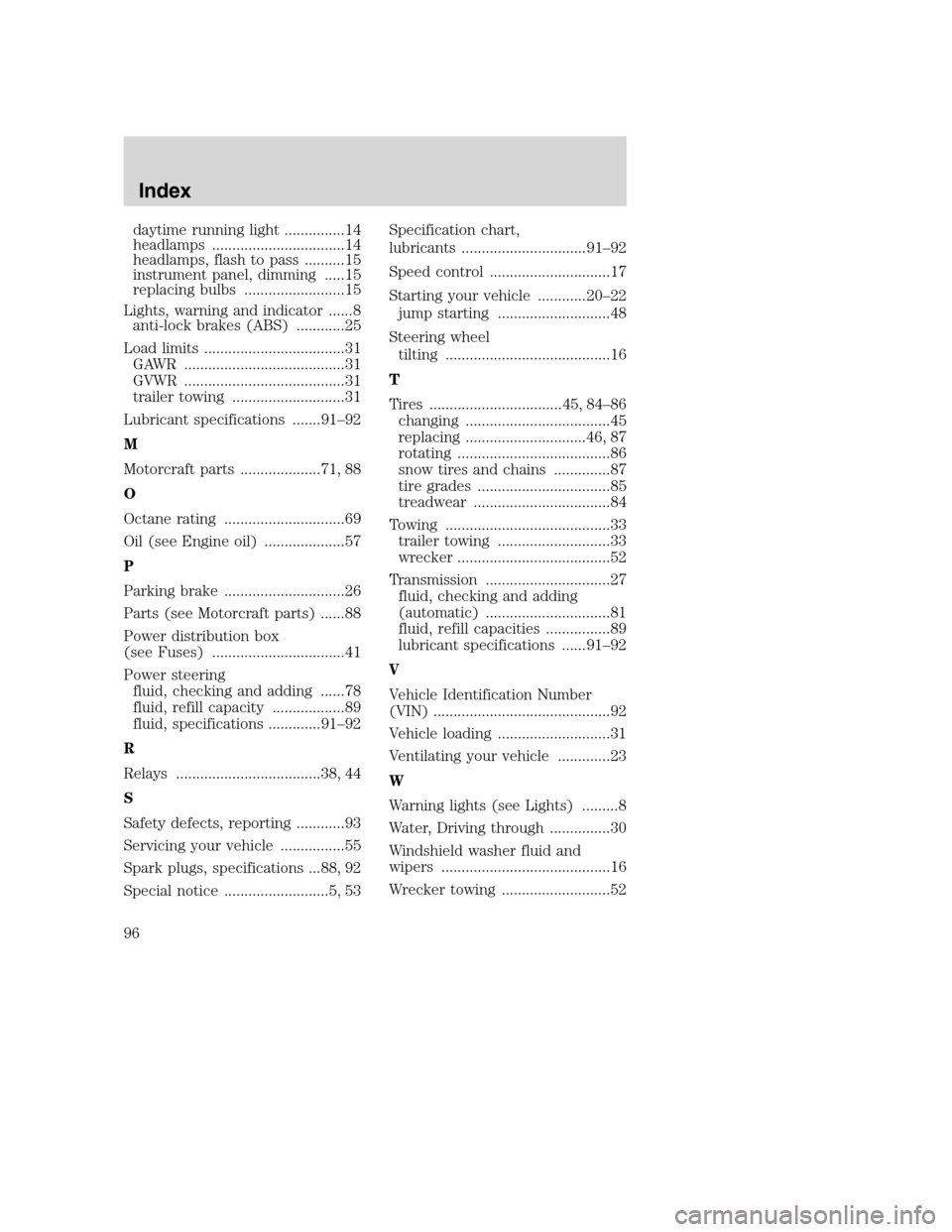
daytime running light ...............14
headlamps .................................14
headlamps, flash to pass ..........15
instrument panel, dimming .....15
replacing bulbs .........................15
Lights, warning and indicator ......8
anti-lock brakes (ABS) ............25
Load limits ...................................31
GAWR ........................................31
GVWR ........................................31
trailer towing ............................31
Lubricant specifications .......91–92
M
Motorcraft parts ....................71, 88
O
Octane rating ..............................69
Oil (see Engine oil) ....................57
P
Parking brake ..............................26
Parts (see Motorcraft parts) ......88
Power distribution box
(see Fuses) .................................41
Power steering
fluid, checking and adding ......78
fluid, refill capacity ..................89
fluid, specifications .............91–92
R
Relays ....................................38, 44
S
Safety defects, reporting ............93
Servicing your vehicle ................55
Spark plugs, specifications ...88, 92
Special notice ..........................5, 53Specification chart,
lubricants ...............................91–92
Speed control ..............................17
Starting your vehicle ............20–22
jump starting ............................48
Steering wheel
tilting .........................................16
T
Tires .................................45, 84–86
changing ....................................45
replacing ..............................46, 87
rotating ......................................86
snow tires and chains ..............87
tire grades .................................85
treadwear ..................................84
Towing .........................................33
trailer towing ............................33
wrecker ......................................52
Transmission ...............................27
fluid, checking and adding
(automatic) ...............................81
fluid, refill capacities ................89
lubricant specifications ......91–92
V
Vehicle Identification Number
(VIN) ............................................92
Vehicle loading ............................31
Ventilating your vehicle .............23
W
Warning lights (see Lights) .........8
Water, Driving through ...............30
Windshield washer fluid and
wipers ..........................................16
Wrecker towing ...........................52
Index
96